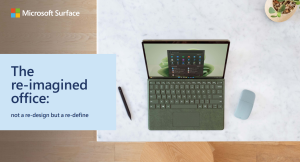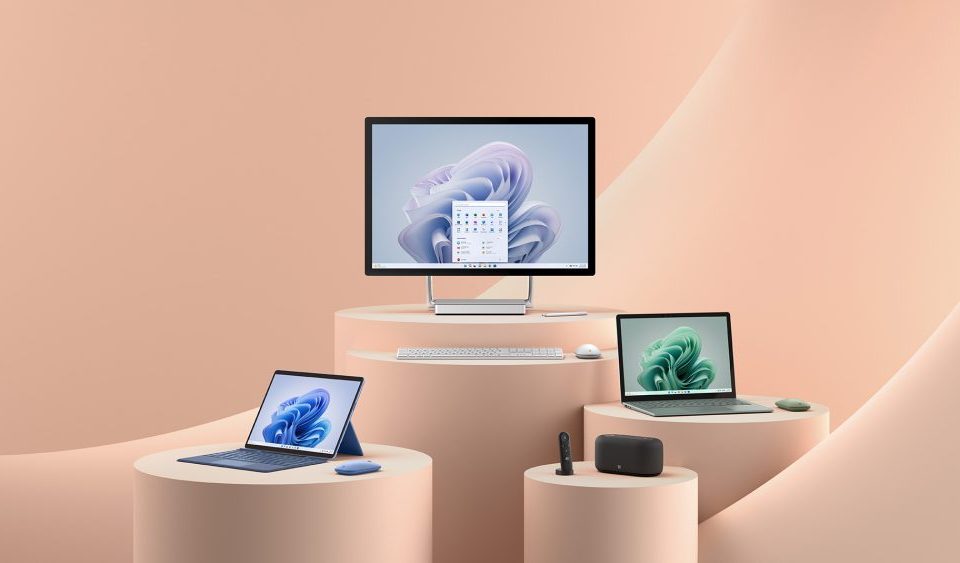New Microsoft Surface report reveals how a lack of investment in sociable and collaborative workplaces may be holding UK employees back from returning to offices
UK businesses are failing to invest in new, collaborative office environments that could encourage staff back into work after the pandemic, a new Microsoft Surface report warns.
More than four in five UK workers (83%) surveyed by YouGov on behalf of Microsoft Surface find themselves still in the same office environment as before the pandemic. Meanwhile, only around one third (35 per cent) of IT decision makers (ITDMs) surveyed for the same report have been asked to consider whether the IT in their office is fit for their workforce today. What’s clear is that the whole way in which we work has changed irrevocably, but our workplaces have not kept pace.
The majority of those surveyed believe that office work is better suited to both socialising with colleagues (57%) and strengthening relationships with colleagues (65%) compared to remote work.
However, the new research indicates that staff are stuck in uncollaborative work patterns when they do venture into the office – the majority (71%) report ‘doing emails’ every time they go in. Additionally, less than one third (31%) of office workers say that their organisation has invested in technology to improve collaboration in the past year – with just 6% of ITDMs recognising meeting room technology as a priority investment.
Perhaps as a result, half (50%) of employees surveyed only go into the office when they’ve been told that they have to. This is worrying, as Microsoft’s Work Trend Index report recently revealed that getting employees back into the office in person is a concern for 80% of UK business leaders in the coming year.
Alan Slothower, Surface Business Group Lead at Microsoft UK, said: “Too many UK workers are stuck in the same office spaces as before the pandemic, their organisations having made little investment in building a sociable and collaborative workspace. Employees clearly need more enticement back to offices than an employer mandate. The question for leaders is clear: Are our offices fit for today’s workforce and will they really want to come back?”
The re-imagined office
The Microsoft Surface report, The re-imagined office: not a re-design but a re-define, draws on the views of thousands of UK employees and more than 500 ITDMs to highlight the importance for organisations to re-imagine their offices for the hybrid road ahead. The report shares insights across three dimensions – collaboration, productivity and employee engagement – surfacing questions for UK business leaders, change managers and ITDMs to consider.
In the report, UK employees share their top three frustrations with office work – feeling like they achieve less than when working remotely (as cited by 36% of respondents); the cost and length of time commuting (32%); and reduced time spent with loved ones (25%).
Interestingly, when asked to imagine a new office workplace, it’s the ‘basics’ they long for. Strong Wi-Fi was the most commonly cited request (49%), followed by good air conditioning with temperature control (47%), and flexible work hours (46%) and good transport links (43%).
But wherever they work, four in five employees (81%) think of their work device – typically a laptop – as their ‘personal office’ to keep them productive wherever they are. Indeed, devices do remain a priority investment for ITDMs in recognition of the crucial role they play to the modern, hybrid worker, according to the research.
Alan Slothower commented: “When the world shifted to remote work a couple of years ago, organisations focused simply on ensuring workforces remained operational by providing people with devices and tools to work from home. Now, as organisations and employees experiment with various types of hybrid models and workers head back to the office once more, business leaders must balance the need for continued productivity with employee expectations of the office – and ensure it is fit for purpose. Our research points to a clear need for businesses to not just re-design their offices, but truly re-imagine them for a hybrid future.”

Notes
To learn more about the findings please find the full report here.
The Microsoft Surface report outlines three key steps which business leaders and change managers need to take in order to make the reimagined office a reality:
- Make employees’ needs central to business strategy – with a change management strategy that considers employees’ needs and reasons for using the office. Not only will this ensure that devices deliver on what they need to, but also enhance the employee experience.
- Accept and address the hybrid paradox – if employers want to encourage greater in-person presence, it starts by understanding that people value flexibility and human connection and letting go of a one-size-fits-all approach.
- View devices as a productivity powerhouse, not just as a technical necessity – the devices which employees use have significant impact on their morale and lead to better productivity and business outcomes. The right devices can also enhance accessibility and create more inclusive experiences for people with disabilities and those working from remote locations.






